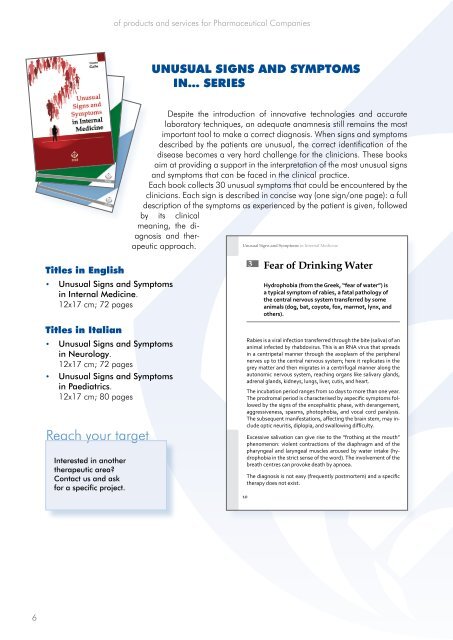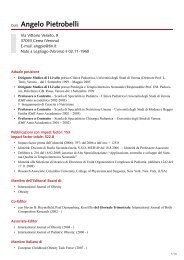2012 - SEEd
2012 - SEEd
2012 - SEEd
Create successful ePaper yourself
Turn your PDF publications into a flip-book with our unique Google optimized e-Paper software.
<strong>SEEd</strong> for Pharma | List of products and services for Pharmaceutical Companies<br />
6<br />
Titles in English<br />
• Unusual Signs and Symptoms<br />
in Internal Medicine.<br />
12x17 cm; 72 pages<br />
Titles in Italian<br />
• Unusual Signs and Symptoms<br />
in Neurology.<br />
12x17 cm; 72 pages<br />
• Unusual Signs and Symptoms<br />
in Paediatrics.<br />
12x17 cm; 80 pages<br />
Reach your target<br />
Interested in another<br />
therapeutic area?<br />
Contact us and ask<br />
for a specific project.<br />
UNUSUAL SIGNS AND SYMPTOMS<br />
IN… SERIES<br />
Despite the introduction of innovative technologies and accurate<br />
laboratory techniques, an adequate anamnesis still remains the most<br />
important tool to make a correct diagnosis. When signs and symptoms<br />
described by the patients are unusual, the correct identification of the<br />
disease becomes a very hard challenge for the clinicians. These books<br />
aim at providing a support in the interpretation of the most unusual signs<br />
and symptoms that can be faced in the clinical practice.<br />
Each book collects 30 unusual symptoms that could be encountered by the<br />
clinicians. Each sign is described in concise way (one sign/one page): a full<br />
description of the symptoms as experienced by the patient is given, followed<br />
by its clinical<br />
meaning, the diagnosis<br />
and therapeutic<br />
approach.<br />
Unusual Signs and Symptoms in Internal Medicine<br />
10<br />
3<br />
Fear of Drinking Water<br />
Hydrophobia (from the Greek, “fear of water”) is<br />
a typical symptom of rabies, a fatal pathology of<br />
the central nervous system transferred by some<br />
animals (dog, bat, coyote, fox, marmot, lynx, and<br />
others).<br />
Rabies is a viral infection transferred through the bite (saliva) of an<br />
animal infected by rhabdovirus. This is an RNA virus that spreads<br />
in a centripetal manner through the axoplasm of the peripheral<br />
nerves up to the central nervous system; here it replicates in the<br />
grey matter and then migrates in a centrifugal manner along the<br />
autonomic nervous system, reaching organs like salivary glands,<br />
adrenal glands, kidneys, lungs, liver, cutis, and heart.<br />
The incubation period ranges from 10 days to more than one year.<br />
The prodromal period is characterised by aspecific symptoms followed<br />
by the signs of the encephalitic phase, with derangement,<br />
aggressiveness, spasms, photophobia, and vocal cord paralysis.<br />
The subsequent manifestations, affecting the brain stem, may include<br />
optic neuritis, diplopia, and swallowing difficulty.<br />
Excessive salivation can give rise to the “frothing at the mouth”<br />
phenomenon: violent contractions of the diaphragm and of the<br />
pharyngeal and laryngeal muscles aroused by water intake (hydrophobia<br />
in the strict sense of the word). The involvement of the<br />
breath centres can provoke death by apnoea.<br />
The diagnosis is not easy (frequently postmortem) and a specific<br />
therapy does not exist.



